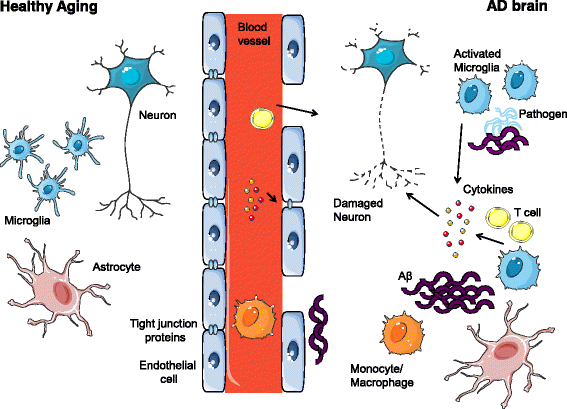Role of neuroinflammation in neurodegeneration: new insights
- PMID: 28259169
- PMCID: PMC5336609
- DOI: 10.1186/s13195-017-0241-2
Role of neuroinflammation in neurodegeneration: new insights
Abstract
Previously, the contribution of peripheral infection to cognitive decline was largely overlooked however, the past 15 years have established a key role for infectious pathogens in the progression of age-related neurodegeneration. It is now accepted that the immune privilege of the brain is not absolute, and that cells of the central nervous system are sensitive to both the inflammatory events occurring in the periphery and to the infiltration of peripheral immune cells. This is particularly relevant for the progression of Alzheimer's disease, in which it has been demonstrated that patients are more vulnerable to infection-related cognitive changes. This can occur from typical infectious challenges such as respiratory tract infections, although a number of specific viral, bacterial, and fungal pathogens have also been associated with the development of the disease. To date, it is not clear whether these microorganisms are directly related to Alzheimer's disease progression or if they are opportune pathogens that easily colonize those with dementia and exacerbate the ongoing inflammation observed in these individuals. This review will discuss the impact of each of these challenges, and examine the changes known to occur with age in the peripheral immune system, which may contribute to the age-related vulnerability to infection-induced cognitive decline.
Keywords: Aging; Alzheimer’s disease; Amyloid-β; Infection; Neuroinflammation; T cells.
Figures

References
-
- United Nations, D.o.E.a.S.A., Population Division, World Population Ageing 2015. 2015: (ST/ESA/SER.A/390).
-
- Westendorp RG. What is healthy aging in the 21st century? Am J Clin Nutr. 2006;83(2):404S–9S. - PubMed
-
- Prince M, et al. World Alzheimer Report 2014: dementia and risk reduction: an analysis of protective and modifiable factors. London: Alzheimer’s Disease International (ADI); 2014.
Publication types
MeSH terms
LinkOut - more resources
Full Text Sources
Other Literature Sources
Medical
Miscellaneous

